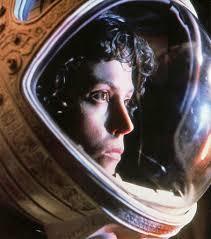Ins and Outs, Part Two
The first rule of Ins and Outs Club is
The Opening and Closing Images of our story should look as alike as reasonably possible.
The second rule of Ins and Outs Club is
At the same time, the Out should be as far away as we can make it, in emotional and narrative terms, from the In.

Sigourney Weaver in the original “Alien”
Last week we cited the opening and closing images from the 1953 Western Shane.
In the In, our hero, the gunfighter Shane (Alan Ladd), enters the Valley carrying aspirations for a better life. He hopes that in this new place he will be able to hang up his six-shooter and start afresh, be a normal person, maybe even find a wife and raise a family.
In the Out, Shane departs the valley by exactly the same route he entered. Only now he knows that that dream will not come true for him—not now, not ever.
In other words, this is exactly how an In and an Out should work.
The closing image resonates powerfully with the opening image—they are bookends really—but in emotional and narrative terms they are as far apart as they can possibly be.
Let’s consider another story, this time a tale of science fiction.
Remember the original Alien from 1979, starring Sigourney Weaver and Tom Skerritt, directed by Ridley Scott, screenplay by Dan O’Bannon, story by Dan O’Bannon and Ronald Shusett?
Alien begins in deep space. Its opening image is that of a huge, black, industrial-looking spacecraft. A crawl identifies the vessel:
commercial towing vehicle “The Nostromo”
crew: seven
cargo: refinery processing 20,000,000 tons of mineral ore
course: returning to Earth
The camera now takes us inside the ship. The command bridge is dimly lit and eerily empty. We see the crew’s helmets meticulously in place at their duty stations, but the crew itself is nowhere to be seen. Apparently the ship’s computers are flying the vessel on auto-pilot.
Suddenly a comm terminal comes to life. A message of some kind rattles in from an external source.
Now the human crew comes into view. We meet them in a separate compartment of the ship, snugged into their hypersleep pods in suspended animation for the long voyage home. Apparently the incoming message contained an order to wake them up, as we now see the compartment’s lights come on and the transparent hatches of the sleep pods elevate open. One by one, the crew members emerge, stretch their limbs, and return to consciousness.
That’s the In.
The Out is a lone crew member (Sigourney Weaver as “Ripley”), accompanied only by the ship’s cat, “Jones,” settling in to a one-person hypersleep pod, about to set the controls that will put her back into suspended animation for the long voyage home.
Ripley is no longer aboard the Nostromo. The Nostromo is gone. Ripley is in “the shuttle,” the equivalent of a lifeboat for the lost ship. As Ripley programs the sleep chamber to take her under, she sends a final message to Earth Control:
RIPLEY
This is Ripley, last survivor of the Nostromo, signing off.
Exactly as with Shane, if we see only the In and Out and nothing more, we get a pretty good idea of what the full movie is about.
They key point is that, though Alien’s opening and closing images resonate and reflect each other—both involve a vessel in deep space, a human in a sleep chamber, and a message received or sent—they are light-years apart emotionally and narratively.
At the start of Alien the crew members, including Ripley, were unconscious literally and figuratively. By the end the others are dead and Ripley herself has woken up completely.
To what has she awoken?
First, she knows now that “the Company”—the unseen executive force that owns and controls the Nostromo—was willing to sacrifice the lives of the entire crew to get their hands on the Alien so they could study it for their Weapons Division. In other words, the world is corrupt and Ripley can count on no one but herself.
Second, Ripley has learned that she is far more capable than she believed herself to be. At the movie’s start, Ripley was second in command to Dallas (Tom Skerritt). She deferred to him. She was deferential as well to Ash (Ian Holm), the ship’s science officer, and even a little cowed by the maintenance dudes, Parker (Yaphet Kotto) and Brett (Harry Dean Stanton).
By the end of the film, Ripley has come into her own. She has survived, and even prevailed, when every other crew member has perished. Like Alan Ladd in Shane, she is not the person at the finish that she was at the start.
The In and Out of both films reflect the first rule of storytelling:
The hero must change as much as possible from the story’s beginning to the story’s end.
That’s the In.
That’s the Out.



